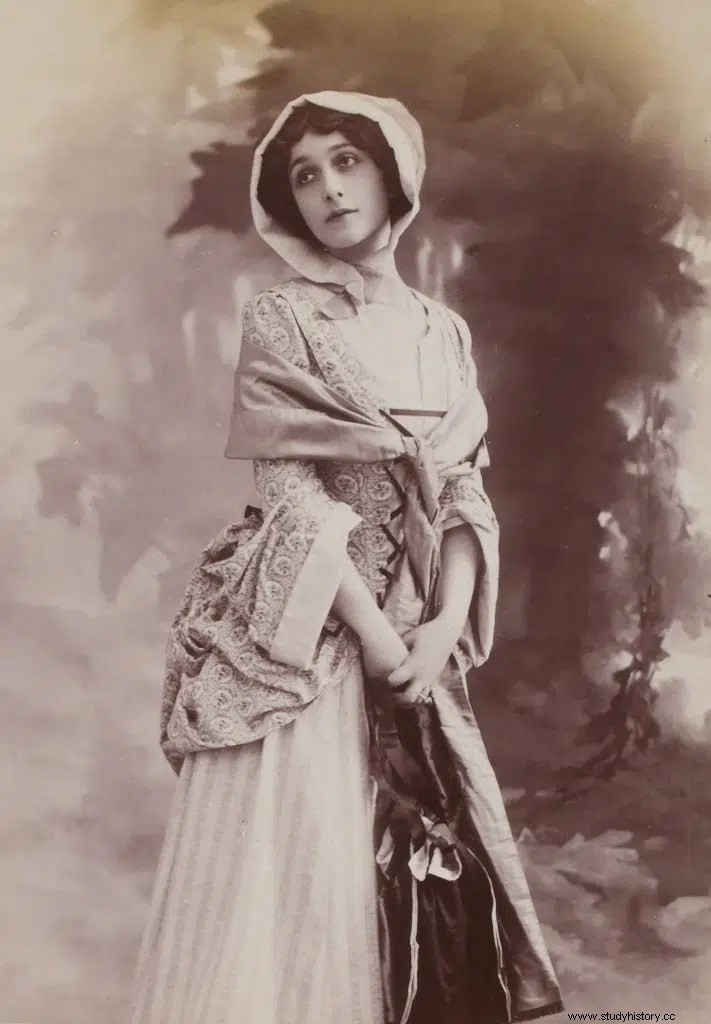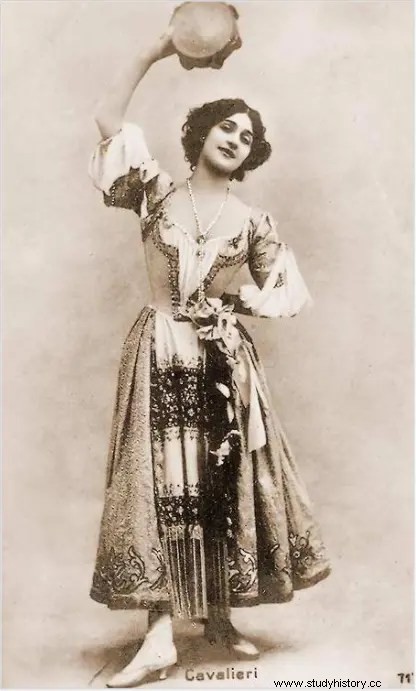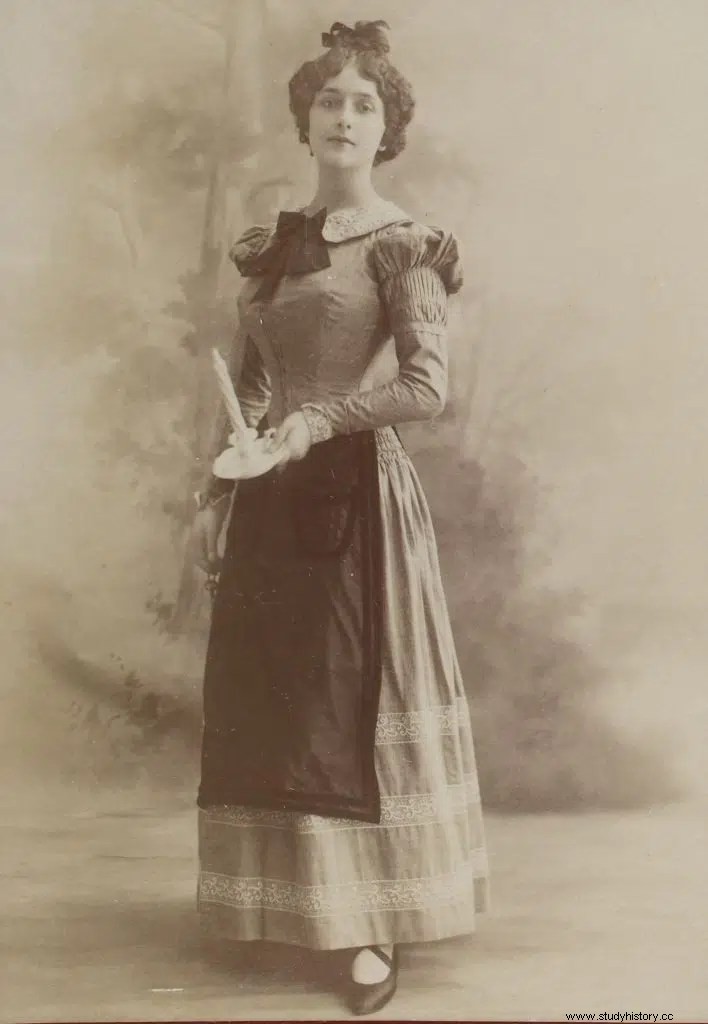Eclipsed in the collective memory by Liane de Pougy, Caroline Otéro or Cléo de Mérode, Lina Cavalieri began her career as a singer at the café-concert, before becoming a soprano at the Opera. Celebrated as one of the most perfect beauties of the demi-monde, the diva seduces four husbands and countless lovers, and arouses enthusiasm around the world. After telling you about the fascinating stories of the too perfect Lillie Langtry, muse of England in the 19th century, the flamboyant Cécile Sorel, queen of the music hall in the 20th century, and the mischievous Anna Held, acclaimed star on Broadway, here is the story of the ambitious Venus Lina Cavalieri, poor Italian who became a diva with an international career.
The violet seller at the Folies Bergères
Little Natalina was born on Christmas Day 1874 in a working-class district of Rome, to a penniless family. Already as a child, we notice his angel face, his great strength of character, his proud and resolute temperament. The young girl helps her mother at home taking care of his siblings:Nino, Oreste and Giulia.
As a teenager, after being a violet seller on the streets, she is employed in a factory as a newspaper folder . Natalina quickly becomes depressed, as this mind-numbing occupation curbs her creative naturalness. To pass the time, she pushes the song, taking advantage of escapades in the prosperous districts of the city to slip into the café concerts where she observes the singers, immerses herself in their facial expressions and their repertoire.

Luckily, a music teacher hears her vocalizations and offers to give her some lessons. He quickly realizes that the beautiful 14-year-old is determined, and that her talent is well above average. He introduces him to the manager of the café in the Piazza Navona , who hires her after hearing her sing fashionable Neapolitan songs. Lina will admit that for her first performances, she "trembled with fear ! It was probably at this time that she was advised to change her name for the diminutive of Lina .
His career is launched. She connects the jobs in the cafés concerts. We begin to recognize her in the streets of Rome as her beauty is astounding. His first major success, at the Grande Orfeo , elevating her to the rank of the most famous artists in the capital.
Aware of the opportunity offered to her, Lina developed her repertoire and worked hard :its popularity continues to grow. Here it is in demand in Naples, Milan… then in Paris.
She arrives on the stage of the Folies Bergères , a real springboard for artists, at the beginning of 1896. In just a few days, she became a star in the French capital and multiplies the performances. His name appears next to those of the famous Liane de Pougy or Caroline Otero on programs distributed in theaters and on posters, feat which she does not fail to underline in her Mémoires . She even replaces Liane de Pougy in the title role of l’Araignée d’Or , after a failed suicide of the beautiful horizontal. Now it is in demand internationally...
From London to Moscow
In May 1897, there she was at the Empire from London :it is a triumph. In June, she arrives in Russia . The whole city is waiting for the arrival of the one nicknamed "the little star of Italy ". Lina sings tunes from her country, accompanied by a women's orchestra with guitars and mandolins . New idol of the public, she is entitled to an ovation every evening at the Krestovsky theater. The Russian actor Rostovtsev notes:“His elegant silhouette and his pretty little face give him the air of a delicate porcelain statue ". The Journal de Saint-Petersburg adds that she is the only woman who knows how to combine “Italian simplicity and French sophistication .

After an autumn at the Folies Bergères, she performs at the Cabaret Aquarium of Saint-Petersburg , in the company of the beautiful Otéro . Lina Cavalieri, personification of angelic and naive beauty, sings scabrous songs, almost seeming to apologize for their indelicate content. She forms with Caroline Otéro, six years older, archetype of the energetic, lively and seductive Spanish woman, an explosive duo.
On December 13, 1897, Lina took a new step in her career. She is invited by the Frenchman Charles Aumont to come and perform on the stage of the Théâtre des varieties of Moscow. Its success is brilliant. The performances follow one another. In front of this bit of woman singing Italian ballads, dancing the tarantella to the sound of the tambourine, the public never ceases to applaud. Wherever it occurs, investing the space with nobility and poetry under the patronage of Aumont, the halls are packed.
At the end of January 1898, she returned to Paris for a new season at the Folies Bergères then spent the summer in Moscow, again in competition with Caroline Otéro . “The two stars competed with each other for the attention of the spectators »
A princess cannot sing…

In November 1899, Lina Cavalieri announced that she was ending her career . Stupor. What happened ? For several months, she has been making perfect love with Prince Alexander Bariatinsky . By marrying him, she agrees to leave the scene , incompatible with her new status as a princess. She swaps her extravagant outfits for irreproachable dresses, her flashy jewelry for a precious set of emeralds given to her by her husband. Lina moves to London with him to lead the orderly life expected of her…
Quickly, the fairy tale turns sour! It is unclear whether the marriage was dissolved by the prince's family , horrified by this union unworthy of her rank, even if the marriage really took place:there is no trace of it in the archives. In his Memoirs , Lina ensures that the divorce is pronounced because she refuses to sacrifice her career for love. And indeed, she cannot resist the call of the stage.
But if she goes back on stage, it is no longer to push the song in the café concerts. She is aiming for the Opera , whom she frequented a lot during her affair with the prince. He introduced her to this new world and put her in touch with influential people. Among them, singer Mariani Masi , who runs a singing school in Saint Petersburg. She agrees to take Lina under her wing and give her lessons. The beauty thus works on her lyrical repertoire.
Having become his mentor, Mariani Masi takes him to Lisbon , where Lina made her debut at the San Carlos Theater January 29, 1900:surrounded by renowned artists, she plays the role of Nedda in the opera Pagliacci by Ruggero Leoncavallo. This premature representation is a failure. Lina does not despair and goes to Italy with Masi to work on her voice . Through perseverance, she manages to evolve her vocal abilities in a record time. She makes a second appearance at the Naples Opera as Mimi in La Bohème by Puccini. The spectators are conquered. The newspapers describe his career as “promising”. In November, she played the role of Violette, Verdi's tragic heroine in La Traviata .
“Perfect personification of Venus”

In the 1900s, Lina Cavalieri achieved the status of a true international star . She never travels without her maids, two servants, a cook, ten musicians and her personal hairdresser. She receives countless gifts from her admirers, many of whom become her lovers . Like all cocottes, she parades on the Côte d’Azur , a resort popular with crowned heads. Often traveling to Monte Carlo, she rubbed shoulders with the best society and made friends with princes and ambassadors.
Earning a good living (nearly 10,000 francs a month, compared to 15 francs at the start!), she bought herself a villa on the Champs-Elysées , which she decorates in Russian style.
Both men and women are full of praise for Lina , “perfect personification of Venus” according to the writer Gabriele d’Annunzio. Seduced by this unreal beauty and her big sad eyes, Giovanni Boldini , one of the most prominent portrait painters at that time, particularly famous for his representations of women, devoted several paintings to him. As for the artist Erté , he paints a most flattering portrait of Lina:
Lina Cavalieri was tall, very slender, with a long, magnificent swan neck. Brunette, she had large black eyes and perfectly defined features. She was the opposite of a cold beauty, for her face, constantly in motion, remained always expressive. But what was most remarkable about her was her extraordinary charm...
Living showcase of the most eminent couturiers, symbol of feminine beauty, Lina becomes famous for her "deep cleavage and hourglass figure ". Unlike its rivals, it does not seek to differentiate itself at all costs by playing the original. It is for her naturalness and her candor that she arouses admiration!
The other actresses start wanting to look like her and wear their hair styled “à la Cavalieri”. It is enough for her to appear in a box at the Opera, wearing a hat adorned with ostrich feathers, her neck adorned with pearls and diamonds, for the crowd to lose interest in the spectacle and turn towards her. /P>
If she goes out on the streets to shop, a troop of onlookers crowd around her. The press comments on the smallest details of his daily life:we debate his delicate health, his intolerance to temperature changes, excess food, and even boring conversations!

The cocottes sell, they become ambassadors for the brands and their products... Lina appears for example as lady of diamonds in a deck of playing cards dating from 1905, alongside the most famous beauties of the time:the Australian Clarisse Campbell as queen of clubs, the Spanish Caroline Otero as queen of spades and the French Cléo de Mérode as queen of heart!
She is also sought after for her beauty advice. Around 1910, she dealt with "the art of being beautiful" for the magazine Femina . A few years ago, she created her own beauty salon avenue Victor-Emmanuel-III, and developed a method to remove rosacea, blackheads and other skin irregularities. She markets her own cosmetics and creates her own perfume brand.
If advertising sometimes brings them closer, the war rages between all these beauties who take turns stealing the show. Jean Cocteau testified in 1913:
I saw Otero and Cavalieri having lunch in Armenonville. It was no small matter (…) These knights bristling with tulle and eyelashes, these sacred beetles armed with asparagus princes, these samurais of sable and ermine, these cuirassiers of pleasure (…) seemed, stiff, in face of their host, being able to get out of an oyster only its pearl.
The Diva
Lina is given more and more roles and she performs in the greatest opera houses in the world . His performance in La Traviata is so acclaimed that she will play it in Russia and Italy. In January 1904 she played the role of Fedora in the opera of the same name by Giordano in Genoa, the following month she was in Trieste as Manon by Jules Massenet. She consolidates her repertoire and acquires a reputation as a diva despite some harsh criticism accusing the “Queen of Diamonds” of also wanting to become “Queen of the Opera”.
In The Illustrated World , André Charlot attributes her success to “her radiant beauty, and her dual talent as a dancer and singer ". Certainly, Lina does not have an extraordinary voice. But she knows it perfectly and makes the best use of it. She works hard and the results are there:she transforms a banal voice into a performing instrument . According to the critic Rupert Christiansen, “his art was something fragile… A light but pretty little voice in harmony with his diaphanous beauty. »
His stage presence also commands attention. His performances are always spontaneous and full of charm. Because if she does research beforehand on the characters she will play “for the rest, she follows her own emotions ". Lina is therefore unpredictable and her way instinctive and natural to play makes it unforgettable. In order to get an idea of Lina's voice, here is a lesson taken from a performance by Lina in Maria Mari by Eduardo Capua:
She gains in technique with each of her new performances. From October 1901 to October 1903, she performed on the Italian stage, doubling the roles of her repertoire . At the beginning of 1904, she returned to her beloved Russia and then returned to France where she performed on the most prestigious stages such as the Sarah Bernhardt theatre , and continues to take lessons with Mariani Masi.
Gaining in confidence, Lina experiences new things, on new stages. She arrives for the first time in the United States in December 1906, when he was offered the Metropolitan Opera for a fee of over $1,000 per performance. Although nervous to face the American public for the first time, she is reassured to find that success is immediate. Her best roles are Mimi in La Bohème by Puccini and Carmen in George Bizet's opera. No less than 28 performances are given during the season. In the winter of 1907/1908, she created Adrienne Lecouvreur and performer Manon Lescaut alongside the great tenor Beniamino Gigli.
His career is not devoid of scandal:on the stage of thisMetropolitan which is so successful for her, when she performs a duet with the famous Caruso in Fedora , an opera by Giordano, she throws herself into the arms of the tenor and kisses him passionately on the mouth! This audacity earned her the nickname "the kissing Primadonna". She remembers:
For the first time in the United States, an actress gave a real kiss on stage. It was a triumph. Some cried scandal, the success was all the greater!
New marriages, new experiences

In 1909, Lina dated the painter Robert Winthrop Chanler , grandson of John Jacob Astor, one of the richest men in the United States. The family, powerful and influential, publicly disapproves. However, they married civilly on June 18, 1910 in Paris. Three months later, Lina files for divorce! The scandal delighted the press and the directors of the theatres:the tickets were sold at exorbitant prices.
Lina continues her career, adding new roles to her repertoire:Madame Butterfly , Romeo and Juliet , Thais … This last opera, by Jules Massenet, is one of his most brilliant successes.
In April 1912, the diva announced her engagement to Lucien Muratore , one of the most famous French tenors. They married in 1913 and Lucien adopted a son that Lina had certainly had very young with a passing love:Alessandro.
The couple displays unclouded happiness. They go on tour in America for duets vibrant with emotion. Happy, smiling, fulfilled, Lina allows herself to be photographed as a couple. But the rhythm of the performances that follow one another extremely tires his voice. She thinks more and more about stopping the scene. However, his career continued until 1921.
His relationship with Lucien also coincided with the beginnings of his passion for filmography . Lina appears in several films shot by her husband. She seems very comfortable in front of the camera , and the movie Manon Lescaux in 1914 is a real success. The following year, she played again with her husband in La Sposa della Morte , screened by Pathé in the United States in 1916. Lina's name was so popular that the film was shown in Russia. The roses of Granada comes out in the United States in 1917, A Woman of Impulse enjoyed great popularity the following year. She continued in this way until 1921, a year that marked both her withdrawal from the stage and from public life :now wishing to live in peace, Lina flees the spotlight.
Return to Italy

Now 46, Lina devotes herself a lot to her family, whom she visits very often, especially her mother before she died of pneumonia in the 1930s. Having divorced Muratore in 1919, the ex-diva retired to her villa in Fiesole near Florence.
She marries the racing driver Giuseppe Campari in 1927. Unfortunately he died in a car accident in 1933. She then began a relationship with his brother, Davide Campari , which ends in 1937.
Aged about sixty, she finally finds happiness with the impresario Arnaldo Pavoni . She spent the last years of her life with him, dividing her time between his villa in Rieti and his other villa in Fiesole, whose doors were always open to Italian and foreign friends. She gives lavish parties accompanied by shows and fireworks.
It was in Fiesole that she died with her companion, victim of an air attack during the Second World War , May 6, 1944. His almost intact body was taken out of the rubble and buried in the Verano cemetery in Rome, where his parents are already buried. Removed from the scene for so many years, her death goes almost unnoticed... A film about her life, made in 1955 and starring Gina Lollobrigida, pays homage to her with the title "The Most Beautiful Woman in the World"... It is still very popular in Italy today.

Sources
♦ Les Cocottes – Queens of Paris 1900  by Catherine Guigon
by Catherine Guigon
♦ Lina Cavalieri:The Life of Opera's Greatest Beauty (1874-1944)  by Paul Fryer and Olga Usova
by Paul Fryer and Olga Usova
♦ The Muses between 1850 and 1950, exceptional women by Evelyne Saez
